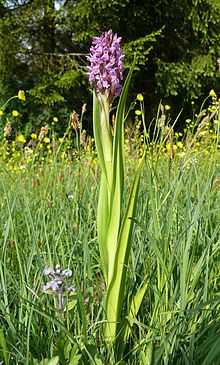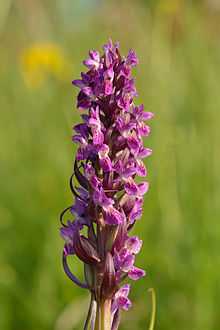Dactylorhiza incarnata
| Early Marsh-orchid | |
|---|---|
 | |
| Dactylorhiza incarnata habitus | |
| Scientific classification | |
| Kingdom: | Plantae |
| (unranked): | Angiosperms |
| (unranked): | Monocots |
| Order: | Asparagales |
| Family: | Orchidaceae |
| Subfamily: | Orchidoideae |
| Genus: | Dactylorhiza |
| Species: | D. incarnata |
| Binomial name | |
| Dactylorhiza incarnata (L.) Soó (1962) | |
| Synonyms[1] | |
| |

Dactylorhiza incarnata, the Early Marsh-orchid,[2] is a perennial, temperate-climate species of orchid generally found growing in wet meadows, and generally on base-rich soils, up to about 2100m asl. The species occurs widely in Europe and Asia from Portugal and Ireland east to Siberia and Xinjiang.[1][2, 3, 4][3][4][5][6][7][8][9]
There are several subspecies and also hybrids[3], rendering the identification of this species more difficult, but typically, the flowering spike is robust with a hollow stem, 25–60 cm tall, and bearing up to 50 flowers. Plants grow to a height of from 15 to 70 cm. The 4–7 erect yellowish-green leaves are hooded at the tip. The inflorescence is 4–12 cm long, with up to 50 blooms. The labellum appears long and narrow, since its sides are strongly reflexed (folded back). The tip is shallowly three-lobed. The flower is often flesh-coloured (the meaning of incarnata) and the labellum normally has loop-shaped markings.
The flowering period is from May to mid-July, dependent on latitude and subspecies[1].
Subspecies
Many names have been proposed for subspecies, varieties and forms within the species. Subspecies recognized as of June 2014:
- Dactylorhiza incarnata subsp. coccinea - British Isles
- Dactylorhiza incarnata subsp. cruenta - from France and Ireland east to Siberia and Xinjiang
- Dactylorhiza incarnata subsp. gemmana - Great Britain, Ireland, Germany, Netherlands
- Dactylorhiza incarnata subsp. incarnata - from Spain and Ireland east to Siberia and Kazakhstan
- Dactylorhiza incarnata subsp. jugicrucis - Transcaucasus
- Dactylorhiza incarnata nothosubsp. krylovii ined. - France and Western Siberia
- Dactylorhiza incarnata subsp. lobelii - Denmark, Norway, Netherlands
- Dactylorhiza incarnata subsp. ochroleuca - British Isles, Sweden, France, Germany, Switzerland, Austria, Baltic Republics
- Dactylorhiza incarnata subsp. pulchella - British Isles, Sweden, France, Austria, Czech Republic
- Dactylorhiza incarnata nothosubsp. versicolor - Germany and Austria (D. incarnata subsp. incarnata × D. incarnata subsp. ochroleuca)
Hybrids have been reported between D. incarnata and D. maculata, D. praetermissa, D. purpurella and D. kerryensis.
References
- ↑ 1.0 1.1 Kew World Checklist of Selected Plant Families
- ↑ "BSBI List 2007" (xls). Botanical Society of Britain and Ireland. Retrieved 2014-10-17.
- ↑ Altervista Flora Italiana, Orchide palmata, Dactylorhiza incarnata (L.) Soó
- ↑ Flora of China v 25 p 116, 紫点掌裂兰 zi dian zhang lie lan, Dactylorhiza incarnata (Linnaeus) Soó subsp. cruenta (O. F. Müller) P. D. Sell, Watsonia. 6: 317. 1967.
- ↑ Castroviejo, S. & al. (eds.) (2005). Flora Iberica 21: 1-366. Real Jardín Botánico, CSIC, Madrid.
- ↑ Takhtajan, A.L. (ed.) (2006). Conspectus Florae Caucasi 2: 1-466. Editio Universitatis Petropolitanae.
- ↑ Griebl, N. (2008). Vorkommen und verbreitung der gattung Dactylorhiza in Österreich. Berichte aus den arbeitskreisen heimische orchideen 25(2): 80-118.
- ↑ Vázquez Pardo, F.M. (2009). Revisión de la familia Orchidaceae en Extremadura (España). Folia Botanica Extremadurensis 3: 1-367.
- ↑ Petrova, A.S., Vladimirov, V. & Stoyanov, Y. (2009). Dactylorhiza maculata subsp. transsilvanica (Orchidaceae): new for the Bulgarian flora. Phytologia Balcanica 15: 389-392.
1. Turner Ettlinger, D.M. (1976) British and Irish Orchids: a field guide
2. Buttler, Karl Peter (1986) Orchideen: die wildwachsenden Arten und Unterarten Europas, Vorderasiens und Nordafrikas.
3. Lang, David (1980) Orchids of Britain: a field guide.
4. Fitter, A.(1978) An Atlas of the Wild Flowers of Britain and Northern Europe.
External links
 Media related to Dactylorhiza incarnata at Wikimedia Commons
Media related to Dactylorhiza incarnata at Wikimedia Commons Data related to Dactylorhiza incarnata at Wikispecies
Data related to Dactylorhiza incarnata at Wikispecies- Den virtuella floran - Distribution (excluding ssp. cruenta
- Dactylorhiza incarnata at the Encyclopedia of Life